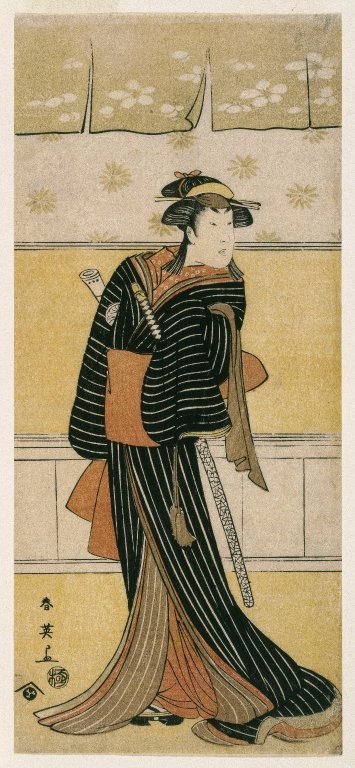|
Katsukawa Shunsai
Katsukawa may refer to: *Katsukawa school, school of Japanese ukiyo-e art, founded by Miyagawa Shunsui *Katsukawa Shunchō, designer of ukiyo-e style Japanese woodblock prints, active from c. 1783 to c. 1795 *Katsukawa Shunkō I (1743–1812), designer of ukiyo-e style Japanese woodblock prints in Edo (Tokyo) *Katsukawa Shunsen, designer of books and ukiyo-e style Japanese woodblock prints *Katsukawa Shunshō Shunshō Katsukawa ( ja, 勝川 春章; 1726 – 19 January 1793) was a Japanese painter and printmaker in the '' ukiyo-e'' style, and the leading artist of the Katsukawa school. Shunshō studied under Miyagawa Shunsui, son and student of M ... (1726–1792), Japanese painter and printmaker in the ukiyo-e style, and the leading artist of the Katsukawa school {{disambiguation, surname Japanese-language surnames ... [...More Info...] [...Related Items...] OR: [Wikipedia] [Google] [Baidu] |
Katsukawa School
The Katsukawa school (勝川派, ''-ha'') was a school of Japanese ''ukiyo-e'' art, founded by Miyagawa Shunsui. It specialized in paintings (''nikuhitsu-ga'') and prints of kabuki actors (''yakusha-e''), sumo wrestlers, and beautiful women (''bijin-ga''). The painter Miyagawa Shunsui changed his surname to Katsukawa. One of his students, Katsukawa Shunshō, took his surname and abandoned the school's tradition of painting well-dressed beauties in favour of ''yakusha-e'' portraits of kabuki actors, a domain once dominated by the Torii school. This new focus revived the actor print, which had lost popularity after Suzuki Harunobu's portraits of beauties rose to prominence in the late 1760s. Shunshō introduced the ''ōkubi-e'' "large-headed picture" in the 1760s. He and other members of the Katsukawa school, such as Shunkō, popularized ''ōkubi yakusha-e'' prints and the dusting of mica in the backgrounds to produce a luxurious glittering effect. Shunsui was the son and stu ... [...More Info...] [...Related Items...] OR: [Wikipedia] [Google] [Baidu] |
Katsukawa Shunchō
was a Japanese designer of ukiyo-e style Japanese woodblock prints, who was active from about 1783 to about 1795. Although a student of Katsukawa Shunshō, Shunchō's output, which consists mostly of prints of beautiful women, more closely resembles the work of Torii Kiyonaga.Newland, Amy Reigle. (2005). ''Hotei Encyclopedia of Japanese Woodblock Prints,'' p. 456. Shunchō also designed many shunga prints, which also resemble those of Torii Kiyonaga. His work is held in the permanent collections of many museums worldwide, including the British Museum, the Portland Art Museum, the University of Michigan Museum of Art, the Nelson-Atkins Museum of Art, the Reading Public Museum, the Gregory Allicar Museum of Art, the Harvard Art Museums, the Minneapolis Institute of Art, the Mead Art Museum at Amherst College, the Hyde Collection, the MOA Museum of Art, the Indianapolis Museum of Art, the Brooklyn Museum, the Suntory Museum of Art, and the Metropolitan Museum of Art. Gallery F ... [...More Info...] [...Related Items...] OR: [Wikipedia] [Google] [Baidu] |
Katsukawa Shunkō I
Katsukawa Shunkō I ( ja, 勝川 春好; 1743 – 1 December 1812) was a Japanese artist who designed ukiyo-e-style woodblock prints and paintings in Edo (modern Tokyo). He was a student of Katsukawa Shunshō, and is generally credited with designing the first large-head actor portraits (ōkubi-e). As his teacher did, Shunkō used a jar-shaped seal and was known as ("little jar"). At 45, the right-handed Shunkō became partially paralyzed and ceased designing prints, although he continued producing paintings with his left hand. Life and career Shunkō lived in Nihonbashi Hasegawachō in Edo (modern Tokyo) and was a student of Katsukawa Shunshō—possibly the master's first. His earliest known work are the illustrations to the book ''Talks about Debut Plays'' (''Kaomise shibai banashi'', 1766). From about 1771, he began to design ''yakusha-e'' actor prints, which he signed with a small jar-shaped seal that appeared next to a larger one by his master; from this h ... [...More Info...] [...Related Items...] OR: [Wikipedia] [Google] [Baidu] |
Katsukawa Shunsen
, who is also known as Shunkō II, was a designer of books and ukiyo-e style Japanese woodblock prints. He was born in 1762 and designed prints from about 1805 to about 1821. He initially studied with the Rimpa school artist Tsutsumi Tōrin III. In 1806 or 1807, Shunsen became a student of Katsukawa Shun'ei, and changed his name from “Kojimachi Shunsen” to “Katsukawa Shunsen”. In 1820 he succeeded Katsukawa Shunkō I, becoming Katsukawa Shunkō II. In the late 1820s, he ceased producing woodblock prints and devoted himself to painting ceramics. He died about 1830. Shunsen is best known for his genre scenes, landscapes A landscape is the visible features of an area of Terrestrial ecoregion, land, its landforms, and how they integrate with Nature, natural or man-made features, often considered in terms of their aesthetic appeal.''New Oxford American Dictionar ..., and prints of beautiful women. Gallery File:Shunsen - (h) carp fishing.jpg, Untitled woodblock pr ... [...More Info...] [...Related Items...] OR: [Wikipedia] [Google] [Baidu] |
Katsukawa Shunshō
Shunshō Katsukawa ( ja, 勝川 春章; 1726 – 19 January 1793) was a Japanese painter and printmaker in the ''ukiyo-e'' style, and the leading artist of the Katsukawa school. Shunshō studied under Miyagawa Shunsui, son and student of Miyagawa Chōshun, both equally famous and talented ukiyo-e artists. Shunshō is most well known for introducing a new form of ''yakusha-e'', prints depicting Kabuki actors. However, his ''bijin-ga'' (images of beautiful women) paintings, while less famous, are said by some scholars to be "the best in the second half of the 8th/nowiki> century".Paine, Robert Treat and Alexander Soper (1955). ''The Art and Architecture of Japan''. New Haven: Yale University Press. p. 263. Biography Shunshō first came to Edo to study haiku and painting. He became a noted printmaker of actors with his first works dating from 1760. Though originally a member of the Torii school, he soon broke away and began his own style, which would later be dubbed the Ka ... [...More Info...] [...Related Items...] OR: [Wikipedia] [Google] [Baidu] |


